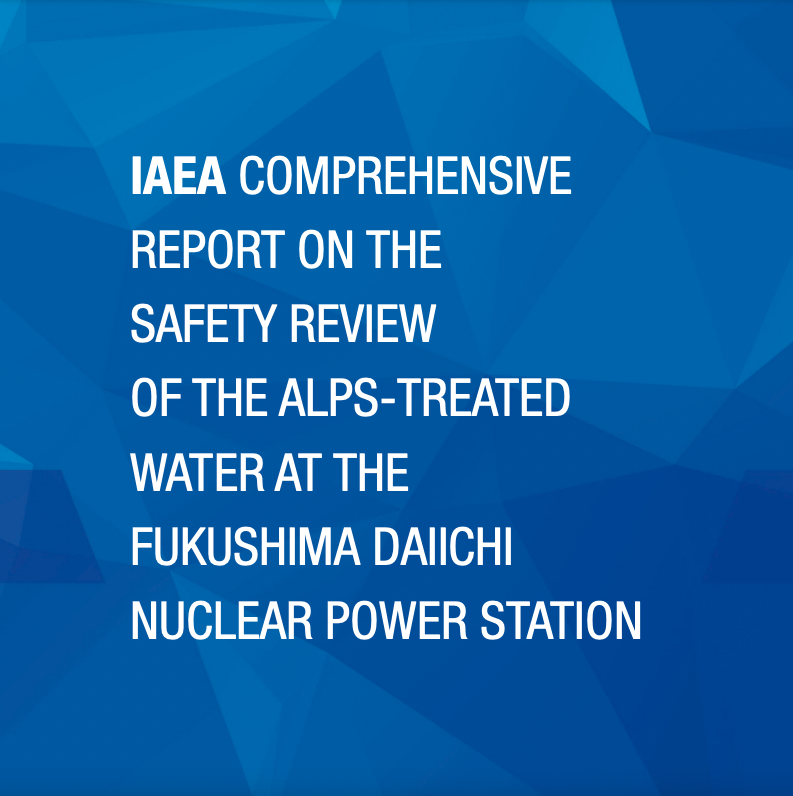CNIC Statement: IAEA Report does not justify ocean discharge of contaminated water from Fukushima Daiichi
6 July 2023
 On July 4, the IAEA submitted to Prime Minister Kishida a report stating that the discharge of contaminated water into the ocean from TEPCO’s Fukushima Daiichi Nuclear Power Station meets international safety standards. The government has stated that it will make a decision on the timing of the start of the discharge, which has been set as “this summer,” after checking the status of efforts to ensure safety and counter rumors.
On July 4, the IAEA submitted to Prime Minister Kishida a report stating that the discharge of contaminated water into the ocean from TEPCO’s Fukushima Daiichi Nuclear Power Station meets international safety standards. The government has stated that it will make a decision on the timing of the start of the discharge, which has been set as “this summer,” after checking the status of efforts to ensure safety and counter rumors.
The IAEA report does not justify the actual discharge of contaminated water into the ocean, but merely evaluates the performance of the discharge facilities and the environmental impact of radioactive materials in the treated water contained in the tanks.
In the ‘Justification’ section in the report, the IAEA states the following:
“Facilities and activities that give rise to radiation risks must yield an overall benefit. Justification is a fundamental principle for the international standards of Radiation protection…
“The request of the Government of Japan to the IAEA to review the application of relevant international safety standards to the discharge of ALPS treated water into the sea was submitted after the Government’s decision was made. Therefore, the scope of the current IAEA safety review did not include an assessment of the details of the justification process followed by the Government of Japan…
“It is clear that the issue of justification of the discharge of ALPS treated water is inherently linked with the overall justification of the decommissioning activities taking place at the FDNPS and thus is influenced by broader and more complex considerations. Decisions regarding justification should be taken at a sufficiently high governmental level to enable all the considerations that may be related to the benefits and detriments to be taken into account.”
The government has explained that discharging contaminated water into the ocean is essential for decommissioning the Fukushima Daiichi Nuclear Power Station. However, the most difficult part of the decommissioning process is the removal of large amounts of fuel debris under conditions of very high radiation. The removal of even a few grams of fuel debris is not feasible and with the final form of decommissioning yet to be determined, the explanation that it is urgent to discharge the contaminated water into the ocean so that the tank storage area can be converted to another use, lacks persuasive power.
Even if this is true, the discharge of contaminated water into the ocean is a benefit that applies only to decommissioning work, and does not benefit society as a whole, including the fishing industry, the tourist industry, the lives of local residents, or the impact on countries other than Japan. The lack of social consensus on ocean discharge is evident in the resolutions of the All Japan Federation of Fishermen’s Associations and the Fukushima Prefectural Federation of Fishermen’s Associations against such discharge, as well as in the concerns raised by countries in and on the coast of the Pacific Ocean. In accordance with the basic principles of international standards 1, ocean discharges cannot be justified.
With regard to the pros and cons of marine discharge, the debate has been steered toward the health effects of tritium, which cannot be removed by the ALPS multinuclide removal system, and the government has argued that the health effects of tritium exposure are inconsequential. However, according to the IAEA report, the largest contribution to the committed effective dose 2 is the intake of marine products, and “the radionuclides that contribute the most to the dose from intake are iodine-129, carbon-14, iron-55, and selenium-79, with a contribution rate of over 90%. It was clearly shown that the impact of nuclides other than tritium accounted for a large proportion of the intake dose.
What is being released from the Fukushima Daiichi Nuclear Power Plant is radioactive contaminated water that has absorbed part of the melted down nuclear fuel and contains radioactive materials of various nuclides; ALPS has not performed as designed and has generated a large amount of treated water with radioactive residues. The amount of contaminated water continues to grow, and the total amount of contaminated water and radioactive materials to be released has not been determined. It is unknown to what extent it will increase and to what extent the environmental impact can be contained.
The government’s way of seeking public understanding has been based on the assumption that their decision to release radioactive materials into the ocean is correct and trying to make the public ‘understand’ that. This way of communicating—ignoring inconvenient facts, trivializing the debate, and attempting to lead public opinion— will not build the “public trust” in nuclear power that the nuclear industry says it is so keenly focused on.
The government must reexamine the handling of contaminated water from scratch, rather than taking it for granted that flushing it into the ocean is the only solution.
(1) The basic principles of radiation protection in the ICRP recommendations are (1) justification of actions, (2) optimization of protection, and (3) individual dose limits.
(2) Whole body radiation dose due to internal body uptake
